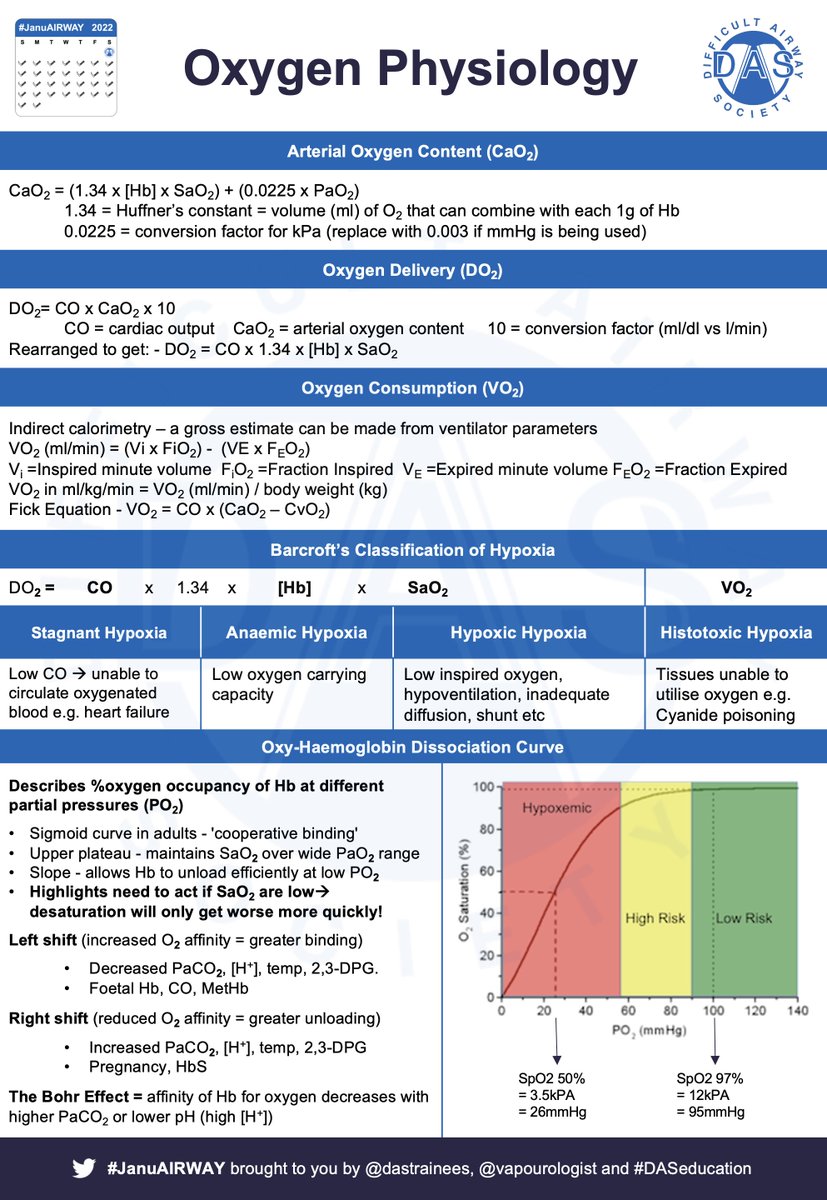
Happy New Year Everyone. Welcome to #JanuAirway. Let’s start with the basics – Oxygen. Meaningful delivery of adequate oxygen is the fundamental aim of airway management. Think A.B.O. – Always, Be, Oxygenating. Here’s a #OnePager covering the basics of oxygen physiology 1/7 

Knowledge of the three basic equations for oxygen physiology is essential: -
Arterial Oxygen Content
Oxygen Delivery
Oxygen Consumption
They can steer us towards various physiological parameters that we can manipulate to treat hypoxia / hypoxaemia. 2/7
#JanuAIRWAY
Arterial Oxygen Content
Oxygen Delivery
Oxygen Consumption
They can steer us towards various physiological parameters that we can manipulate to treat hypoxia / hypoxaemia. 2/7
#JanuAIRWAY
Oxygen cascade shows levels and processes involved and differentials for hypoxia/hypoxaemia: -
Oxygenation (e.g. low O2)
Diffusion (e.g. pulm fib)
Ventilation (bullae)
Perfusion (low cardiac output)
Oxygen carriage (anaemia)
Oxygen demand / use (sepsis) 3/7
#JanuAIRWAY
Oxygenation (e.g. low O2)
Diffusion (e.g. pulm fib)
Ventilation (bullae)
Perfusion (low cardiac output)
Oxygen carriage (anaemia)
Oxygen demand / use (sepsis) 3/7
#JanuAIRWAY
Oxy-Hb curve shows why the focus in desaturation must be getting oxygen in, when SpO2 starts to fall, it’s slow to start then precipitous. The benefit is, often a little oxygen going back in, in general means a rapid rise back to safety. 4/7
#JanuAIRWAY
#JanuAIRWAY

Pre/apnoeic oxygenation must be done well. Patience, VC breaths +/- high flow nasal oxygen are key. We’ll cover Optiflow & jet ventilation later this month, here are #OnePagers covering NO-DESAT by @airwaycam & THRIVE by Anil Patel and @larynxUK. 5/7 #FOAMed #JanuAIRWAY 5/7 



Here are some articles that might be of interest: -
pubmed.ncbi.nlm.nih.gov/25388828/
pubmed.ncbi.nlm.nih.gov/16029221/
epmonthly.com/article/no-des…
If you have any others of interest, tweet them to us for inclusion next time! 6/7
pubmed.ncbi.nlm.nih.gov/25388828/
pubmed.ncbi.nlm.nih.gov/16029221/
epmonthly.com/article/no-des…
If you have any others of interest, tweet them to us for inclusion next time! 6/7
That wraps up day 1. Tomorrow we’ll look at the bedside tests for airway assessment. #JanuAIRWAY 7/7
*Disclaimer: Inclusion of content (equipment, techniques and scoring systems etc.) in #JanuAIRWAY does not constitute DAS endorsement
*Disclaimer: Inclusion of content (equipment, techniques and scoring systems etc.) in #JanuAIRWAY does not constitute DAS endorsement
• • •
Missing some Tweet in this thread? You can try to
force a refresh




